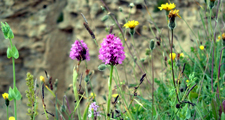Grasslands
Semi-natural grasslands have long been recognised as highly valued features of the Durham countryside, and make an enormous contribution to its biodiversity because of the diverse floral and faunal assemblages that they support including the rare and nationally important plant species Teesdale Violet, Spring Gentian and Dark Red Helleborine. They are also important for invertebrates including Northern Brown Argus Butterfly and nesting birds (Curlew, Lapwing and Skylark).
The plant communities found in semi-natural grasslands vary across the county, reflecting changes in geology, soils, climate and the influence of human activity. Dry semi-natural grasslands may also grade very quickly into wetter grassland and mire habitats, where rushes are often characteristic. Some grassland types are closely associated with one landscape type or County Character Area for example species rich upland hay meadows are found in the North Pennines, whilst magnesian limestone grasslands are similarly limited in their distribution, occurring only the East Durham Limestone Plateau; others are more widespread in their distribution and show little change in their composition over a broad geographical range.
The importance of many of these grasslands is often recognised through their designation as Sites of Special Scientific Interest (SSSI) and Special Areas of Conservation(SAC).
For further information on grasslands in County Durham, the grassland National Vegetation Communities that occur and guidance on grassland management and creation, download the following PDF:



